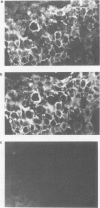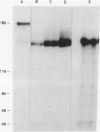Abstract
In a previous study we have shown that monoclonal antibody MR6, which we believe recognizes a component of the human IL-4 receptor complex, binds to a wide variety of epithelial tumours. We have now used this reagent to carry out more detailed analysis of tumours of the breast. Our immunohistochemical data indicate that approximately 30% of these tumours show elevated expression of the molecule to which MR6 binds. In addition, three samples of lymphoma were all MR6-positive. Normal breast tissue from the same patients was either negative or weakly positive. Immunoprecipitation and Western blotting analysis with MR6 show that the molecule expressed on tumour cells is indistinguishable from that on normal tissues. It has an apparent molecular weight of 200 kD, but is highly sensitive to proteolysis yielding a molecule of 145 kD. These data raise the possibility that upregulation of the IL-4 receptor complex may be involved in tumourigenesis. In addition, since only a third of tumours are MR6-positive, the antibody may have potential in differential diagnosis.
Full text
PDF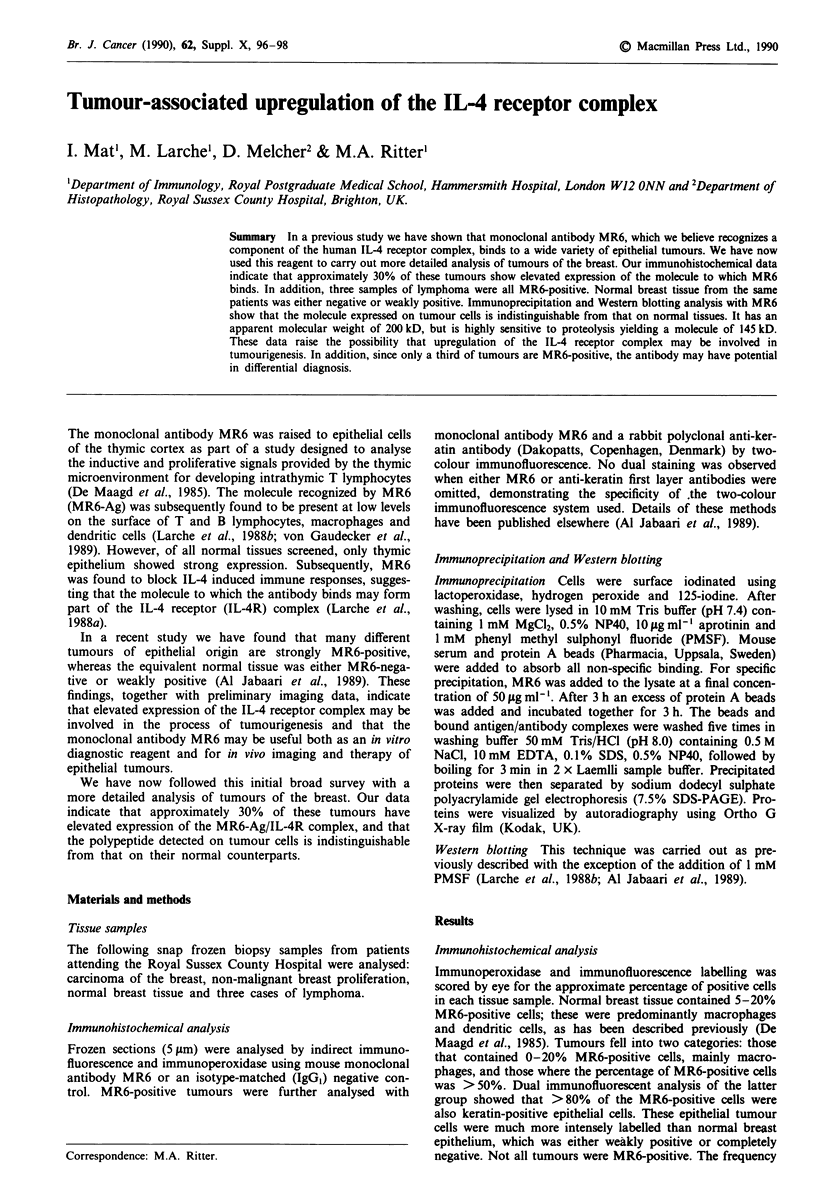
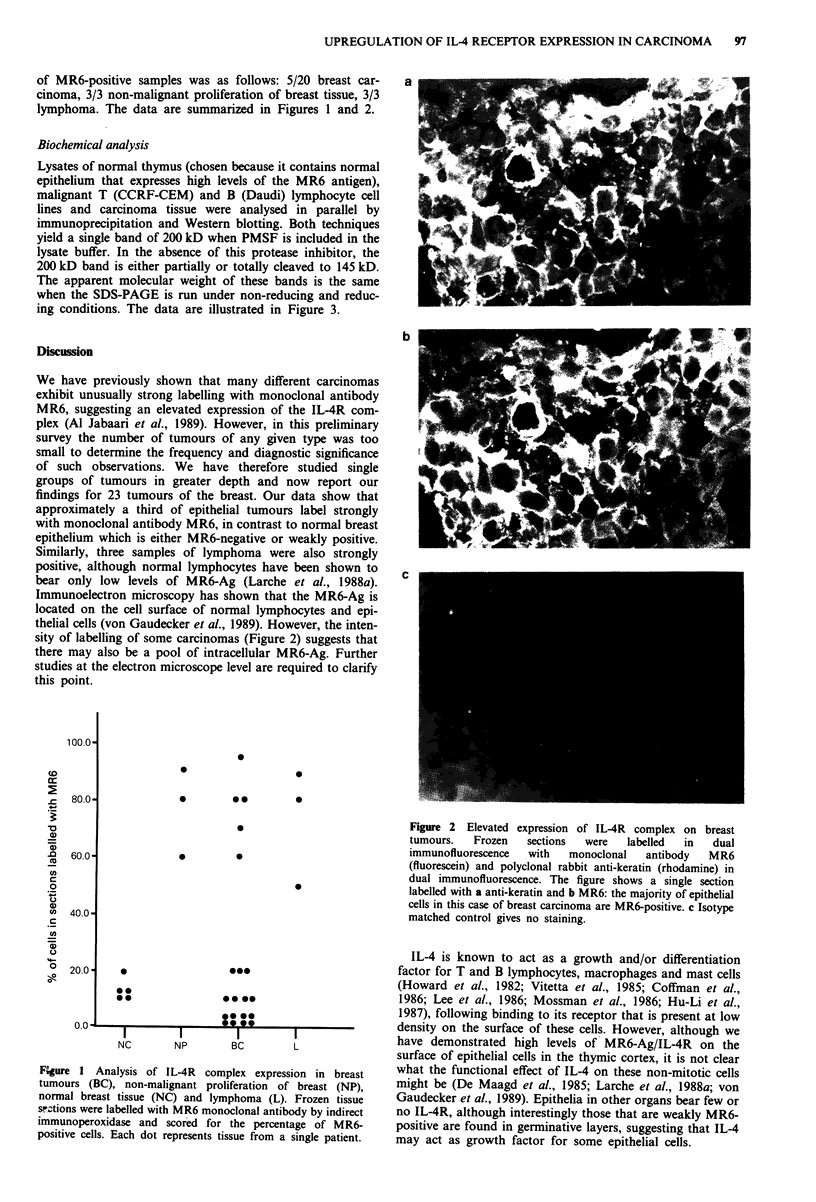
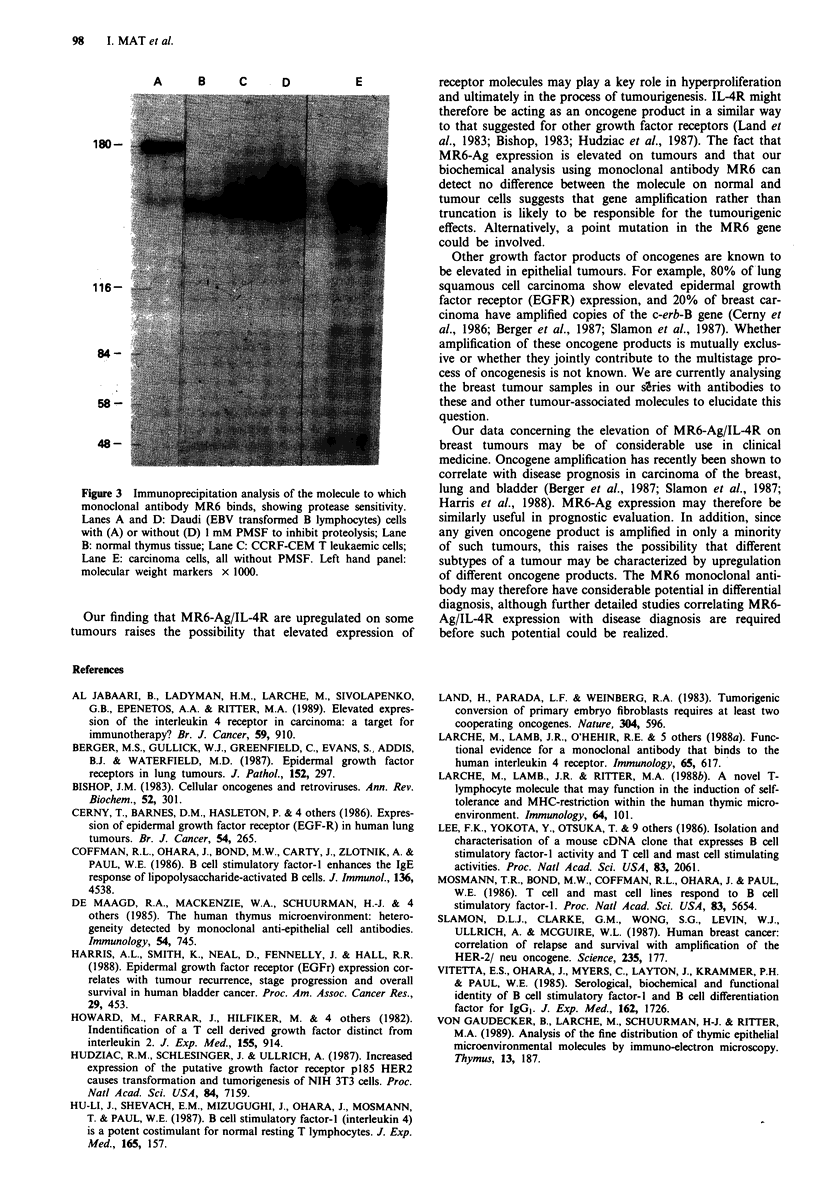
Images in this article
Selected References
These references are in PubMed. This may not be the complete list of references from this article.
- Al Jabaari B., Ladyman H. M., Larché M., Sivolapenko G. B., Epenetos A. A., Ritter M. A. Elevated expression of the interleukin 4 receptor in carcinoma: a target for immunotherapy? Br J Cancer. 1989 Jun;59(6):910–914. doi: 10.1038/bjc.1989.192. [DOI] [PMC free article] [PubMed] [Google Scholar]
- Berger M. S., Gullick W. J., Greenfield C., Evans S., Addis B. J., Waterfield M. D. Epidermal growth factor receptors in lung tumours. J Pathol. 1987 Aug;152(4):297–307. doi: 10.1002/path.1711520408. [DOI] [PubMed] [Google Scholar]
- Bishop J. M. Cellular oncogenes and retroviruses. Annu Rev Biochem. 1983;52:301–354. doi: 10.1146/annurev.bi.52.070183.001505. [DOI] [PubMed] [Google Scholar]
- Cerny T., Barnes D. M., Hasleton P., Barber P. V., Healy K., Gullick W., Thatcher N. Expression of epidermal growth factor receptor (EGF-R) in human lung tumours. Br J Cancer. 1986 Aug;54(2):265–269. doi: 10.1038/bjc.1986.172. [DOI] [PMC free article] [PubMed] [Google Scholar]
- Coffman R. L., Ohara J., Bond M. W., Carty J., Zlotnik A., Paul W. E. B cell stimulatory factor-1 enhances the IgE response of lipopolysaccharide-activated B cells. J Immunol. 1986 Jun 15;136(12):4538–4541. [PubMed] [Google Scholar]
- Howard M., Farrar J., Hilfiker M., Johnson B., Takatsu K., Hamaoka T., Paul W. E. Identification of a T cell-derived b cell growth factor distinct from interleukin 2. J Exp Med. 1982 Mar 1;155(3):914–923. doi: 10.1084/jem.155.3.914. [DOI] [PMC free article] [PubMed] [Google Scholar]
- Hu-Li J., Shevach E. M., Mizuguchi J., Ohara J., Mosmann T., Paul W. E. B cell stimulatory factor 1 (interleukin 4) is a potent costimulant for normal resting T lymphocytes. J Exp Med. 1987 Jan 1;165(1):157–172. doi: 10.1084/jem.165.1.157. [DOI] [PMC free article] [PubMed] [Google Scholar]
- Hudziak R. M., Schlessinger J., Ullrich A. Increased expression of the putative growth factor receptor p185HER2 causes transformation and tumorigenesis of NIH 3T3 cells. Proc Natl Acad Sci U S A. 1987 Oct;84(20):7159–7163. doi: 10.1073/pnas.84.20.7159. [DOI] [PMC free article] [PubMed] [Google Scholar]
- Land H., Parada L. F., Weinberg R. A. Tumorigenic conversion of primary embryo fibroblasts requires at least two cooperating oncogenes. Nature. 1983 Aug 18;304(5927):596–602. doi: 10.1038/304596a0. [DOI] [PubMed] [Google Scholar]
- Larche M., Lamb J. R., O'Hehir R. E., Imami-Shita N., Zanders E. D., Quint D. E., Moqbel R., Ritter M. A. Functional evidence for a monoclonal antibody that binds to the human IL-4 receptor. Immunology. 1988 Dec;65(4):617–622. [PMC free article] [PubMed] [Google Scholar]
- Larché M., Lamb J. R., Ritter M. A. A novel T-lymphocyte molecule that may function in the induction of self-tolerance and MHC-restriction within the human thymic microenvironment. Immunology. 1988 May;64(1):101–105. [PMC free article] [PubMed] [Google Scholar]
- Lee F., Yokota T., Otsuka T., Meyerson P., Villaret D., Coffman R., Mosmann T., Rennick D., Roehm N., Smith C. Isolation and characterization of a mouse interleukin cDNA clone that expresses B-cell stimulatory factor 1 activities and T-cell- and mast-cell-stimulating activities. Proc Natl Acad Sci U S A. 1986 Apr;83(7):2061–2065. doi: 10.1073/pnas.83.7.2061. [DOI] [PMC free article] [PubMed] [Google Scholar]
- Mosmann T. R., Bond M. W., Coffman R. L., Ohara J., Paul W. E. T-cell and mast cell lines respond to B-cell stimulatory factor 1. Proc Natl Acad Sci U S A. 1986 Aug;83(15):5654–5658. doi: 10.1073/pnas.83.15.5654. [DOI] [PMC free article] [PubMed] [Google Scholar]
- Slamon D. J., Clark G. M., Wong S. G., Levin W. J., Ullrich A., McGuire W. L. Human breast cancer: correlation of relapse and survival with amplification of the HER-2/neu oncogene. Science. 1987 Jan 9;235(4785):177–182. doi: 10.1126/science.3798106. [DOI] [PubMed] [Google Scholar]
- Vitetta E. S., Ohara J., Myers C. D., Layton J. E., Krammer P. H., Paul W. E. Serological, biochemical, and functional identity of B cell-stimulatory factor 1 and B cell differentiation factor for IgG1. J Exp Med. 1985 Nov 1;162(5):1726–1731. doi: 10.1084/jem.162.5.1726. [DOI] [PMC free article] [PubMed] [Google Scholar]
- de Maagd R. A., MacKenzie W. A., Schuurman H. J., Ritter M. A., Price K. M., Broekhuizen R., Kater L. The human thymus microenvironment: heterogeneity detected by monoclonal anti-epithelial cell antibodies. Immunology. 1985 Apr;54(4):745–754. [PMC free article] [PubMed] [Google Scholar]
- von Gaudecker B., Larché M., Schuurman H. J., Ritter M. A. Analysis of the fine distribution of thymic epithelial microenvironmental molecules by immuno-electron microscopy. Thymus. 1989;13(3-4):187–194. [PubMed] [Google Scholar]



